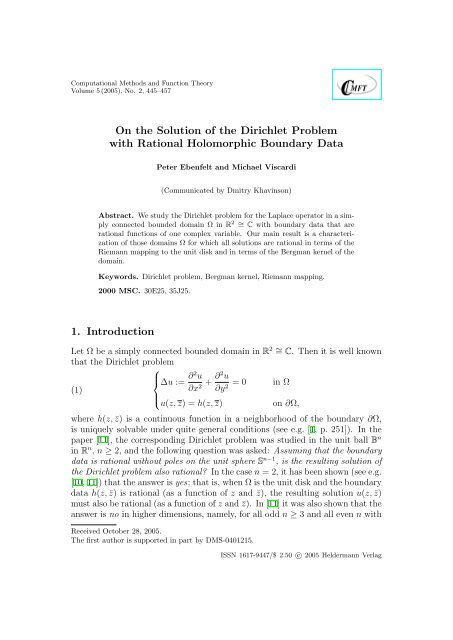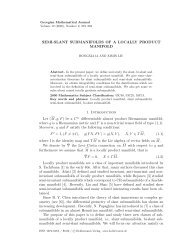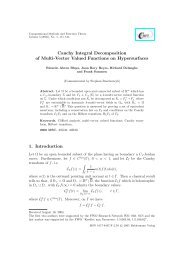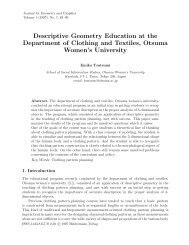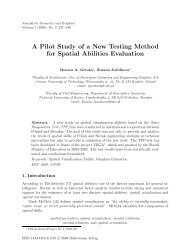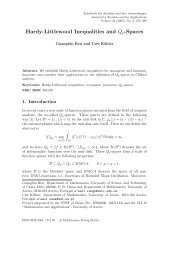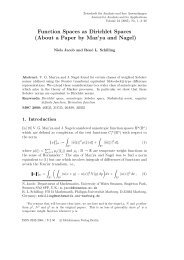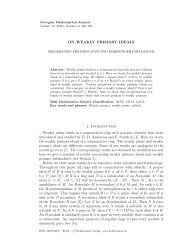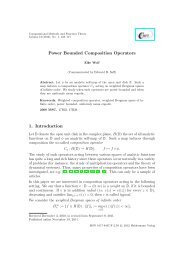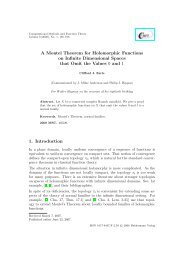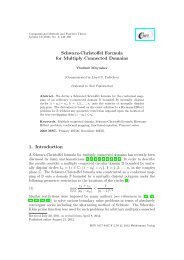On the Solution of the Dirichlet Problem with Rational Holomorphic ...
On the Solution of the Dirichlet Problem with Rational Holomorphic ...
On the Solution of the Dirichlet Problem with Rational Holomorphic ...
Create successful ePaper yourself
Turn your PDF publications into a flip-book with our unique Google optimized e-Paper software.
Computational Methods and Function Theory<br />
Volume 5 (2005), No. 2, 445–457<br />
<strong>On</strong> <strong>the</strong> <strong>Solution</strong> <strong>of</strong> <strong>the</strong> <strong>Dirichlet</strong> <strong>Problem</strong><br />
<strong>with</strong> <strong>Rational</strong> <strong>Holomorphic</strong> Boundary Data<br />
Peter Ebenfelt and Michael Viscardi<br />
(Communicated by Dmitry Khavinson)<br />
Abstract. We study <strong>the</strong> <strong>Dirichlet</strong> problem for <strong>the</strong> Laplace operator in a simply<br />
connected bounded domain Ω in R 2 ∼ = C <strong>with</strong> boundary data that are<br />
rational functions <strong>of</strong> one complex variable. Our main result is a characterization<br />
<strong>of</strong> those domains Ω for which all solutions are rational in terms <strong>of</strong> <strong>the</strong><br />
Riemann mapping to <strong>the</strong> unit disk and in terms <strong>of</strong> <strong>the</strong> Bergman kernel <strong>of</strong> <strong>the</strong><br />
domain.<br />
Keywords. <strong>Dirichlet</strong> problem, Bergman kernel, Riemann mapping.<br />
2000 MSC. 30E25, 35J25.<br />
1. Introduction<br />
Let Ω be a simply connected bounded domain in R 2 ∼ = C. Then it is well known<br />
that <strong>the</strong> <strong>Dirichlet</strong> problem<br />
⎧<br />
⎪⎨ ∆u := ∂2 u<br />
(1)<br />
∂x + ∂2 u<br />
2 ∂y = 0 in Ω<br />
2<br />
⎪⎩<br />
u(z, z) = h(z, z)<br />
on ∂Ω,<br />
where h(z, ¯z) is a continuous function in a neighborhood <strong>of</strong> <strong>the</strong> boundary ∂Ω,<br />
is uniquely solvable under quite general conditions (see e.g. [1, p. 251]). In <strong>the</strong><br />
paper [11], <strong>the</strong> corresponding <strong>Dirichlet</strong> problem was studied in <strong>the</strong> unit ball B n<br />
in R n , n ≥ 2, and <strong>the</strong> following question was asked: Assuming that <strong>the</strong> boundary<br />
data is rational <strong>with</strong>out poles on <strong>the</strong> unit sphere S n−1 , is <strong>the</strong> resulting solution <strong>of</strong><br />
<strong>the</strong> <strong>Dirichlet</strong> problem also rational? In <strong>the</strong> case n = 2, it has been shown (see e.g.<br />
[10, 11]) that <strong>the</strong> answer is yes; that is, when Ω is <strong>the</strong> unit disk and <strong>the</strong> boundary<br />
data h(z, ¯z) is rational (as a function <strong>of</strong> z and ¯z), <strong>the</strong> resulting solution u(z, ¯z)<br />
must also be rational (as a function <strong>of</strong> z and ¯z). In [11] it was also shown that <strong>the</strong><br />
answer is no in higher dimensions, namely, for all odd n ≥ 3 and all even n <strong>with</strong><br />
Received October 28, 2005.<br />
The first author is supported in part by DMS-0401215.<br />
ISSN 1617-9447/$ 2.50 c○ 2005 Heldermann Verlag
446 P. Ebenfelt and M. Viscardi CMFT<br />
4 ≤ n ≤ 270 (although, presumably, this holds also for all even n ≥ 4). In o<strong>the</strong>r<br />
papers (e.g. [2, 3, 8]), <strong>the</strong> analogous question <strong>with</strong> polynomials replacing rational<br />
functions was investigated on annuli, ellipsoids, and o<strong>the</strong>r quadratic surfaces. We<br />
mention in particular <strong>the</strong> paper [13] in which it was shown that <strong>the</strong> solutions to<br />
<strong>the</strong> <strong>Dirichlet</strong> problem (in any number <strong>of</strong> dimensions n ≥ 2) <strong>with</strong> polynomial data<br />
are always polynomial if and only if Ω is an ellipsoid. This resolves a conjecture<br />
by Khavinson and Shapiro [12].<br />
It is natural to extend <strong>the</strong>se studies by considering <strong>the</strong> question in more general<br />
domains. In this paper, we let Ω be any simply connected bounded domain<br />
in C and take <strong>the</strong> boundary data h(z, ¯z) to be a rational function <strong>of</strong> z <strong>with</strong>out<br />
poles on ∂Ω. Note, in particular, that <strong>the</strong> boundary data is holomorphic in a<br />
neighborhood <strong>of</strong> ∂Ω. The case where h(z, ¯z) is allowed to be a rational function<br />
<strong>of</strong> both z and ¯z is quite different, and is <strong>the</strong> subject <strong>of</strong> <strong>the</strong> forthcoming paper [7].<br />
We shall be concerned <strong>with</strong> characterizing those Ω for which <strong>the</strong> solution to<br />
<strong>the</strong> <strong>Dirichlet</strong> problem (1) is rational whenever <strong>the</strong> boundary data h(z, ¯z) is a<br />
rational function <strong>of</strong> z <strong>with</strong> no poles on ∂Ω. Clearly, if this happens, <strong>the</strong>n <strong>the</strong><br />
boundary <strong>of</strong> Ω is contained in a real-analytic (indeed, real-algebraic) variety. We<br />
shall here fur<strong>the</strong>r assume that ∂Ω is smooth and, hence, that <strong>the</strong> boundary is a<br />
real-analytic (non-singular) curve. Observe that when ∂Ω is a real-analytic curve<br />
and h(z, ¯z) is real-analytic near ∂Ω, <strong>the</strong>n <strong>the</strong>re is a unique holomorphic function<br />
R(z) near ∂Ω such that h(z, ¯z) = R(z) on ∂Ω. Hence, ano<strong>the</strong>r way <strong>of</strong> formulating<br />
<strong>the</strong> main hypo<strong>the</strong>sis in this paper, under <strong>the</strong> a priori assumption that ∂Ω is a<br />
real-analytic curve and <strong>the</strong> boundary data is real-analytic, is that <strong>the</strong> unique<br />
holomorphic extension R(z) <strong>of</strong> h(z, ¯z) is a rational function. Since any simply<br />
connected bounded domain Ω is conformally equivalent to <strong>the</strong> unit disk D, we are<br />
naturally led to results involving <strong>the</strong> Riemann maps <strong>of</strong> Ω onto <strong>the</strong> unit disk D.<br />
Fur<strong>the</strong>rmore, in [5] it is shown that <strong>the</strong> Bergman kernel K(z, w) associated <strong>with</strong> Ω<br />
is rational (as a function <strong>of</strong> z and ¯w) if and only if any Riemann map is rational.<br />
Thus, we also obtain connections between <strong>the</strong> <strong>Dirichlet</strong> problem and <strong>the</strong> Bergman<br />
kernel, all <strong>of</strong> which are contained in our main <strong>the</strong>orem, Theorem 1.<br />
2. Main results<br />
Our main results are summarized in <strong>the</strong> following <strong>the</strong>orem.<br />
Theorem 1. Let Ω be a simply connected bounded domain in C <strong>with</strong> smooth<br />
real-analytic boundary, and take distinct points a, a 1 , a 2 ∈ Ω. Let K(z, w) denote<br />
<strong>the</strong> Bergman kernel associated <strong>with</strong> Ω. Then <strong>the</strong> following are equivalent.<br />
(i) The solution to <strong>the</strong> <strong>Dirichlet</strong> problem (1) is rational for<br />
h(z, ¯z) = 1<br />
z − a .
5 (2005), No. 2 The <strong>Dirichlet</strong> <strong>Problem</strong> <strong>with</strong> <strong>Rational</strong> <strong>Holomorphic</strong> Data 447<br />
(ii) The solution to <strong>the</strong> <strong>Dirichlet</strong> problem (1) is rational for h(z, ¯z) = R(z),<br />
where R(z) is any rational function <strong>with</strong>out poles on ∂Ω.<br />
(iii) The Riemann map f : Ω → D is rational.<br />
(iv) K(z, a 1 ) and K(z, a 2 ) are rational functions <strong>of</strong> z.<br />
(v) K(z, w) is a rational function <strong>of</strong> z and ¯w.<br />
We mention here a result by S. Bell [5] stating that <strong>the</strong> Bergman kernel on a<br />
multiply connected domain is rational if and only if <strong>the</strong> domain is simply connected<br />
and a Riemann map f : Ω → D is rational. This implies <strong>the</strong> equivalence<br />
(iii) ⇐⇒ (v) above. However, <strong>the</strong> pro<strong>of</strong> we give is independent <strong>of</strong> Bell’s result.<br />
The pro<strong>of</strong> proceeds as follows: We first prove a preliminary lemma, <strong>the</strong>n prove<br />
<strong>the</strong> chain <strong>of</strong> implications (v) ⇒ (iv) ⇒ (iii) ⇒ (ii) ⇒ (i) ⇒ (v). For clarity, we<br />
have written out some <strong>of</strong> <strong>the</strong>se implications as <strong>the</strong>orems.<br />
We conclude this section <strong>with</strong> a few remarks concerning notation. Throughout<br />
<strong>the</strong> pro<strong>of</strong> <strong>of</strong> Theorem 1 we shall use <strong>the</strong> notation<br />
g ∗ (z) := g(z),<br />
and shall use O(Ω) to denote <strong>the</strong> space <strong>of</strong> analytic functions in Ω. (Note that g<br />
is holomorphic in some domain Ω if and only if g ∗ is holomorphic in <strong>the</strong> domain<br />
Ω ∗ := {z : ¯z ∈ Ω}.) We shall use <strong>the</strong> notation P 1 for <strong>the</strong> Riemann sphere (a.k.a.<br />
<strong>the</strong> extended complex plane). We also use <strong>the</strong> notation C(z) for <strong>the</strong> field <strong>of</strong><br />
rational functions in z.<br />
3. Pro<strong>of</strong> <strong>of</strong> Theorem 1<br />
We start by proving <strong>the</strong> following simple lemma.<br />
Lemma 1. Suppose f is an algebraic function whose derivative is rational.<br />
Then f itself is rational.<br />
Pro<strong>of</strong>. Let a 1 , a 2 , . . . , a n be <strong>the</strong> distinct poles <strong>of</strong> f ′ . Expand f ′ in terms <strong>of</strong> its<br />
singular parts:<br />
n∑<br />
f ′ (z) = p(z) + s k (z)<br />
(2)<br />
= p(z) +<br />
= p(z) +<br />
k=1<br />
n∑<br />
p k<br />
∑<br />
k=1 j=1<br />
p n∑ ∑ k<br />
k=1 j=2<br />
c k,j<br />
(z − a k ) j<br />
c k,j<br />
n∑<br />
(z − a k ) + j<br />
k=1<br />
c k,1<br />
z − a k<br />
,<br />
where <strong>the</strong> p k and c k,j are fixed constants, and p(z) is a polynomial.
448 P. Ebenfelt and M. Viscardi CMFT<br />
For 1 ≤ k ≤ n and j ≥ 2,<br />
∫<br />
c k,j<br />
(z − a k ) dz = c k,j 1<br />
j 1 − j (z − a k ) + d j−1 k,j ∈ C(z), d k,j ∈ C.<br />
For 1 ≤ k ≤ n, ∫<br />
c k,1<br />
z − a k<br />
dz = c k,1 log(z − a k ) + d k , d k ∈ C.<br />
Thus, integrating both sides <strong>of</strong> equation (2)) yields:<br />
n∑<br />
(3) f(z) = p(z) + r(z) + b k (z),<br />
where r is a rational function and b k (z) := c k,1 log(z−a k ). Suppose c 1,1 ≠ 0. Since<br />
<strong>the</strong> a k are distinct, it follows that b 1 (z) has infinitely many branches near <strong>the</strong><br />
point a 1 while b 2 (z), . . . , b n (z) are analytic <strong>the</strong>re. This is a contradiction, since<br />
we are assuming f is algebraic (and hence has only finitely many branches). We<br />
conclude that c 1,1 = 0. Similarly, we obtain c k,1 = 0 for k = 2, . . . , n. Thus, <strong>the</strong><br />
summation in equation (3) is equal to zero, so<br />
as desired.<br />
k=1<br />
f(z) = p(z) + r(z) ∈ C(z),<br />
We now proceed to <strong>the</strong> pro<strong>of</strong> <strong>of</strong> Theorem 1.<br />
(v) ⇒ (iv). This is trivial.<br />
(iv) ⇒ (iii). Suppose that K(z, a 1 ) and K(z, a 2 ) are rational functions <strong>of</strong> z.<br />
By composing f <strong>with</strong> an appropriate Möbius transformation, we may assume<br />
<strong>with</strong>out loss <strong>of</strong> generality that f(a 1 ) = 0. We shall use <strong>the</strong> following standard<br />
formula for <strong>the</strong> Bergman kernel:<br />
(4) K(z, w) =<br />
Taking w = a 1 , we have<br />
f ′ (z)f ′ (w)<br />
π(1 − f(z)f(w)) 2 .<br />
K(z, a 1 ) = f ′ (a 1 )<br />
π<br />
f ′ (z).<br />
Since K(z, a 1 ) is a rational function <strong>of</strong> z, this implies that f ′ (z) is rational.<br />
Now take w = a 2 in equation (4) to get<br />
i.e.<br />
K(z, a 2 ) =<br />
f ′ (z)f ′ (a 2 )<br />
π(1 − f(z)f(a 2 )) 2 ,<br />
π(1 − f(z)f(a 2 )) 2 K(z, a 2 ) − f ′ (z)f ′ (a 2 ) = 0.
5 (2005), No. 2 The <strong>Dirichlet</strong> <strong>Problem</strong> <strong>with</strong> <strong>Rational</strong> <strong>Holomorphic</strong> Data 449<br />
Since K(z, a 2 ) and f ′ (z) are rational, this implies that f(z) is algebraic. Thus,<br />
by Lemma 1, f is rational, as desired.<br />
For ease <strong>of</strong> reading, we shall write <strong>the</strong> implication (iii) ⇒ (ii) as a <strong>the</strong>orem.<br />
Theorem 2. Let Ω be a domain as in Theorem 1, and suppose that a Riemann<br />
map f : Ω → D is rational. Then <strong>the</strong> solution to <strong>the</strong> <strong>Dirichlet</strong> problem<br />
{<br />
∆u = 0 in Ω<br />
u(z, z) = R(z)<br />
on ∂Ω<br />
is rational for every rational function R(z) <strong>with</strong>out poles on ∂Ω.<br />
Pro<strong>of</strong>. Fix a rational function R(z), and let a 1 , a 2 , . . . , a n be <strong>the</strong> poles <strong>of</strong> R in Ω.<br />
Expanding R in terms <strong>of</strong> its singular parts, we have<br />
(5) R(z) =<br />
n∑<br />
s k (z) + ˜R(z) =<br />
k=1<br />
n∑<br />
p k<br />
∑<br />
k=1 j=1<br />
c k,j<br />
(z − a k ) j + ˜R(z),<br />
where <strong>the</strong> p k and c k,j are fixed constants, and <strong>the</strong> function ˜R(z) is holomorphic<br />
in Ω and rational. We now propose <strong>the</strong> following lemma.<br />
Lemma 2. For any fixed k, 1 ≤ k ≤ n, <strong>the</strong>re exist constants b k,j<br />
rational function Q k (z) ∈ O(Ω) such that<br />
(6)<br />
p k<br />
∑<br />
j=1<br />
p<br />
b k,j<br />
[f(z) − f(a k )] = ∑ k<br />
c k,j<br />
j (z − a k ) + Q k(z).<br />
j<br />
j=1<br />
∈ C and a<br />
Pro<strong>of</strong> <strong>of</strong> Lemma 2. Expanding f(z) as a power series about <strong>the</strong> point a k yields<br />
i.e.<br />
Thus, we have<br />
(7)<br />
f(z) = f(a k ) + f ′ (a k )(z − a k ) + O(z − a k ) 2 ,<br />
f(z) − f(a k ) = (z − a k )[f ′ (a k ) + O(z − a k )].<br />
b k,j<br />
[f(z) − f(a k )] = b k,j<br />
1<br />
j (z − a k ) j [f ′ (a k ) + O(z − a k )] j<br />
b k,j<br />
1<br />
=<br />
f ′ (a k ) j (z − a k ) j [1 + O(z − a k )] . j<br />
Recall that f is one-to-one in Ω, so that f ′ (a k ) ≠ 0 (since a k ∈ Ω). Hence,<br />
it is permissible to have this term in <strong>the</strong> denominator <strong>of</strong> <strong>the</strong> right-hand side <strong>of</strong>
450 P. Ebenfelt and M. Viscardi CMFT<br />
equation (7). We now Taylor expand <strong>the</strong> second term in <strong>the</strong> right-hand side <strong>of</strong><br />
equation (7) about <strong>the</strong> point a k to obtain<br />
(8)<br />
b k,j<br />
[f(z) − f(a k )] j<br />
b k,j<br />
=<br />
f ′ (a k ) j (z − a k ) [1 + e 1,j(z − a k ) + e 2,j (z − a k ) 2 + · · · ]<br />
j<br />
= b [<br />
k,j 1<br />
f ′ (a k ) j (z − a k ) + e 1,j<br />
j (z − a k ) + · · · + e ]<br />
j−1,j<br />
+ ψ j−1 k (z) ,<br />
z − a k<br />
where <strong>the</strong> e n,j are constants in C and ψ k is rational (since we are assuming that f<br />
is rational).<br />
Now, b k,j /[f(z) − f(a k )] j clearly has a pole at a k , as well as at all o<strong>the</strong>r points z<br />
such that f(z) = f(a k ). However, since a k ∈ Ω and f is one-to-one inside Ω, a k<br />
is <strong>the</strong> only pole <strong>of</strong> <strong>the</strong> b k,j /[f(z) − f(a k )] j in Ω. Thus, a k is <strong>the</strong> only pole in Ω<br />
<strong>of</strong> <strong>the</strong> right-hand side <strong>of</strong> equation (8). But note that, by construction, ψ k does<br />
not have a pole at a k ; hence, ψ k only has poles outside <strong>of</strong> Ω. So ψ k is a rational<br />
function and holomorphic in Ω.<br />
We now sum both sides <strong>of</strong> equation (8) as j goes from 1 to p k to get<br />
(9)<br />
Define<br />
p k<br />
∑<br />
j=1<br />
b k,j<br />
[f(z) − f(a k )] j<br />
=<br />
p<br />
∑ k<br />
[<br />
b k,j<br />
f<br />
j=1<br />
′ (a k ) j<br />
p<br />
∑ k<br />
+ψ k (z)<br />
j=1<br />
1<br />
(z − a k ) + e 1,j<br />
j (z − a k ) + · · · + e ]<br />
j−1,j<br />
j−1 z − a k<br />
b k,j<br />
f ′ (a k ) j .<br />
Q k (z) := ψ k (z)<br />
p k<br />
∑<br />
j=1<br />
b k,j<br />
f ′ (a k ) j .<br />
Since ψ k ∈ O(Ω) and is rational, we conclude that Q k ∈ O(Ω) and that Q k is<br />
rational. Thus, Q k satisfies <strong>the</strong> conditions <strong>of</strong> Lemma 2.<br />
For ease <strong>of</strong> notation, let us also define <strong>the</strong> following:<br />
Note that<br />
e 0,j := 1,<br />
(10) d j,j =<br />
d l,j := e (j−l),j<br />
f ′ (a k ) j , 1 ≤ l ≤ j, 1 ≤ j ≤ p k.<br />
1 ≠ 0 for all j.<br />
f ′ (a k )<br />
j
5 (2005), No. 2 The <strong>Dirichlet</strong> <strong>Problem</strong> <strong>with</strong> <strong>Rational</strong> <strong>Holomorphic</strong> Data 451<br />
Equation (9) can now be written as<br />
(11)<br />
p k<br />
∑<br />
j=1<br />
p<br />
b k,j<br />
[f(z) − f(a k )] = ∑ k j<br />
j=1<br />
j∑<br />
l=1<br />
d l,j b k,j<br />
(z − a k ) l + Q k(z).<br />
Reversing <strong>the</strong> order <strong>of</strong> summation in <strong>the</strong> right-hand side <strong>of</strong> equation (11) yields<br />
(12)<br />
p k<br />
∑<br />
j=1<br />
j=1<br />
b k,j<br />
[f(z) − f(a k )] j<br />
= p k<br />
∑<br />
=<br />
p k<br />
∑<br />
l=1 j=l<br />
p<br />
∑ k<br />
l=1<br />
j=1<br />
d l,j b k,j<br />
(z − a k ) l + Q k(z)<br />
∑ pk<br />
j=l d l,jb k,j<br />
(z − a k ) l + Q k (z).<br />
We now swap <strong>the</strong> indices l and j in <strong>the</strong> right-hand side <strong>of</strong> equation (12) to get<br />
p k p<br />
∑ b<br />
k<br />
∑<br />
k,j<br />
(13)<br />
[f(z) − f(a k )] = ∑ pk<br />
l=j d j,lb k,l<br />
+ Q j (z − a k ) j k (z).<br />
Thus, by equation (6) we want to show that <strong>the</strong>re exist b k,j ∈ C such that<br />
p<br />
∑ k<br />
∑ pk<br />
l=j d p<br />
j,lb k,l<br />
∑ k<br />
c k,j<br />
+ Q<br />
(z − a k ) j k (z) =<br />
(z − a k ) + Q k(z),<br />
j<br />
i.e.<br />
i.e.<br />
j=1<br />
p k<br />
∑<br />
l=j<br />
p k<br />
∑<br />
j=1<br />
∑ pk<br />
l=j d j,lb k,l<br />
(z − a k ) j =<br />
j=1<br />
p k<br />
∑<br />
j=1<br />
c k,j<br />
(z − a k ) j ,<br />
d j,l b k,l = c k,j for all j, 1 ≤ j ≤ p k .<br />
Writing this as a system <strong>of</strong> equations, we get<br />
d 1,1 b k,1 + d 1,2 b k,2 + · · · + d 1,pk b k,pk = c k,1<br />
d 2,2 b k,2 + · · · + d 2,pk b k,pk = c k,2<br />
.<br />
d pk ,p k<br />
b k,pk = c k,pk .<br />
The resulting coefficient matrix<br />
⎛<br />
⎞<br />
d 1,1 d 1,2 . . . d 1,pk<br />
0 d<br />
A = ⎜ 2,2 . . . d 2,pk<br />
⎝ .<br />
⎟<br />
. . .. .<br />
⎠<br />
0 0 . . . d pk ,p k<br />
is triangular, so<br />
det A = d 1,1 d 2,2 . . . d pk ,p k ≠ 0
452 P. Ebenfelt and M. Viscardi CMFT<br />
by equation (10). By Cramer’s Rule, we may solve uniquely for <strong>the</strong> b k,j so that<br />
<strong>the</strong>y satisfy <strong>the</strong> above system <strong>of</strong> equations, and <strong>the</strong>refore satisfy equation (6).<br />
Thus, we have found <strong>the</strong> desired b k,j and Q k (z), proving Lemma 2.<br />
We shall now use <strong>the</strong> results <strong>of</strong> Lemma 2 to construct <strong>the</strong> desired function u.<br />
Sum both sides <strong>of</strong> equation (6) as k goes from 1 to n to get<br />
p n∑ k p<br />
∑ b k,j<br />
n∑<br />
[f(z) − f(a<br />
k=1 j=1<br />
k )] = ∑ k<br />
c k,j<br />
n∑<br />
j (z − a<br />
k=1 j=1 k ) + Q j k (z)<br />
k=1<br />
(14)<br />
= R(z) − ˜R(z)<br />
n∑<br />
+ Q k (z),<br />
where <strong>the</strong> second equality follows from equation (5). Define<br />
S(z) := ˜R(z)<br />
n∑<br />
− Q k (z),<br />
ˆT (w) :=<br />
n∑<br />
k=1 j=1<br />
k=1<br />
p<br />
∑ k<br />
k=1<br />
b k,j<br />
[w − f(a k )] j .<br />
By Lemma 2 and <strong>the</strong> paragraph preceding it, S(z) ∈ O(Ω) and is rational. Also,<br />
since f is a bijective rational map from Ω to D and a k ∈ Ω for all k, we know<br />
that ˆT (w) is rational and ˆT (w) ∈ O(P 1 \D).<br />
Substituting <strong>the</strong>se new functions into equation (14), we obtain<br />
i.e.<br />
ˆT (f(z)) = R(z) − S(z),<br />
(15) R(z) = S(z) + ˆT (f(z)).<br />
We now make one final substitution<br />
( )<br />
T (z) := ˆT 1 ∗ .<br />
f(z)<br />
Note that T is rational since ˆT and f are rational. Fur<strong>the</strong>rmore, since f : Ω → D<br />
and I : D → P 1 \D (where I denotes <strong>the</strong> inversion in <strong>the</strong> plane) are both bijective,<br />
T (z) ∈ O(Ω) since ˆT (z) ∈ O(P 1 \D).<br />
Finally, for z ∈ ∂Ω, we know that f(z) ∈ ∂D = {w : |w| 2 = ww = 1}, which<br />
gives<br />
( ) ( )<br />
T (z) = ˆT 1 ∗ =<br />
f(z)<br />
ˆT 1<br />
= ˆT (f(z)),<br />
f(z)<br />
so that equation (15) becomes<br />
(16) R(z) = S(z) + T (z) for z ∈ ∂Ω.
5 (2005), No. 2 The <strong>Dirichlet</strong> <strong>Problem</strong> <strong>with</strong> <strong>Rational</strong> <strong>Holomorphic</strong> Data 453<br />
We now define<br />
(17) u(z, z) := S(z) + T (z).<br />
Since S, T ∈ O(Ω), u is harmonic in Ω, and for z ∈ ∂Ω, equation (16) yields<br />
u(z, z) = R(z).<br />
Hence, u is <strong>the</strong> solution to <strong>the</strong> <strong>Dirichlet</strong> problem posed in Theorem 2. Since S<br />
and T are rational, equation (17) implies that u is rational. This completes <strong>the</strong><br />
pro<strong>of</strong> <strong>of</strong> Theorem 2.<br />
(ii) ⇒ (i). This is trivial.<br />
We shall also write <strong>the</strong> implication (i) ⇒ (v) as a <strong>the</strong>orem.<br />
Theorem 3. Let Ω be as in Theorem 1, and let a ∈ Ω. Suppose <strong>the</strong> solution u<br />
to <strong>the</strong> <strong>Dirichlet</strong> problem<br />
⎧<br />
⎨∆u = 0<br />
in Ω<br />
⎩u(z, z) = 1 on ∂Ω<br />
z − a<br />
is rational. Then <strong>the</strong> Bergman kernel K(z, w) associated <strong>with</strong> Ω is also rational.<br />
Pro<strong>of</strong>. Since u is harmonic in Ω, we may write u(z, z) = s(z) + t(z), where<br />
s, t ∈ O(Ω). Fur<strong>the</strong>rmore, since u is rational, s and t are also rational. Define<br />
R(z) := 1 − s(z) + t(z).<br />
z − a<br />
Note that R is rational. Since u(z, z) = s(z) + t(z) = 1/(z − a) on ∂Ω, we have<br />
R(z) = 1 − s(z) + t(z) = t(z) + t(z) ∈ R<br />
z − a<br />
on ∂Ω.<br />
Thus, we have constructed a rational function R such that R(∂Ω) ⊂ R.<br />
Now, since <strong>the</strong> boundary <strong>of</strong> Ω is a smooth real-analytic closed curve, it is well<br />
known that u can be extended as a harmonic function to an open neighborhood<br />
<strong>of</strong> Ω (this follows from a version <strong>of</strong> <strong>the</strong> Schwarz Reflection Principle; see<br />
e.g. [9, 14]). Thus, s and t can be extended as holomorphic functions past <strong>the</strong><br />
boundary <strong>of</strong> Ω; in particular, <strong>the</strong>y will be continuous on ∂Ω, so R will also be<br />
continuous on ∂Ω. Since Ω is bounded and simply connected, ∂Ω is a compact,<br />
connected subset <strong>of</strong> C. So by <strong>the</strong> above, R(∂Ω) is a compact, connected subset<br />
<strong>of</strong> R, i.e. a closed interval L = [z 1 , z 2 ] ⊂ R.<br />
Lemma 3. R maps Ω bijectively to P 1 \L ′ , where L ′ is some closed subinterval<br />
<strong>of</strong> L, i.e. L ′ = [z 3 , z 4 ] ⊆ [z 1 , z 2 ] <strong>with</strong> z 3 < z 4 .
454 P. Ebenfelt and M. Viscardi CMFT<br />
Pro<strong>of</strong> <strong>of</strong> Lemma 3. Consider <strong>the</strong> function<br />
F (w) := 1 ∫<br />
R ′ (z)<br />
2πi R(z) − w dz,<br />
∂Ω<br />
w ∈ C\L.<br />
Note that F is analytic on C\L since R(∂Ω) = L. Let Z S (g) and P S (g) denote <strong>the</strong><br />
number <strong>of</strong> zeros and poles, respectively, <strong>of</strong> a function g in a domain S (counting<br />
multiplicity). The Argument Principle implies<br />
(18) F (w) = Z Ω [R(z) − w] − P Ω [R(z) − w] for all w ∈ C\L.<br />
Since <strong>the</strong> right-hand side <strong>of</strong> equation (18) is always an integer, F must be constant<br />
(since F (w) is analytic on C\L and C\L is connected). Also, note that<br />
lim w→∞ F (w) = 0, so in fact F ≡ 0. Since R has exactly one (simple) pole in Ω<br />
at <strong>the</strong> point a by definition, equation (18) now yields<br />
Z Ω [R(z) − w] = P Ω [R(z) − w] = 1<br />
for all w ∈ C\L.<br />
So <strong>the</strong> equation R(z) = w has exactly one solution in Ω for any w ∈ C\L. Since<br />
R −1 (L) is at most a proper real-analytic variety in Ω, we conclude that R is a<br />
one-to-one mapping onto R(Ω), and we have<br />
(19) P 1 \L ⊆ R(Ω) ⊆ P 1 .<br />
We now choose a suitable Möbius transformation ϕ such that ϕ(R(Ω)) does not<br />
contain <strong>the</strong> point ∞, i.e.<br />
(20) P 1 \M ⊆ ϕ(R(Ω)) ⊆ C,<br />
where M = ϕ(L). Then, since Ω is simply connected and ϕ(R(z)) is one-toone<br />
and analytic in Ω, ϕ(R(Ω)) is a simply connected subset <strong>of</strong> C. It is well<br />
known that this is equivalent to saying that M ′ := P 1 \ϕ(R(Ω)) is connected<br />
(see [9, p. 202]). Also, note that ϕ(R(Ω)) is an open subset <strong>of</strong> P 1 by <strong>the</strong> open<br />
mapping <strong>the</strong>orem (see [9, p. 99]), so M ′ is a closed subset <strong>of</strong> P 1 . By equation (20),<br />
we <strong>the</strong>refore have ϕ(R(Ω)) = P 1 \M ′ for some closed, connected, possibly empty<br />
subset M ′ ⊆ M. Thus, R(Ω) = P 1 \L ′ for some closed, possibly empty subinterval<br />
L ′ ⊆ L.<br />
If L ′ = ∅, <strong>the</strong>n R(Ω) = P 1 , which is impossible since P 1 is compact while Ω is<br />
not.<br />
If L ′ = {z 0 } for some z 0 , <strong>the</strong>n R(Ω) = P 1 \{z 0 }, which is also impossible since this<br />
would imply that Ω is conformally equivalent to C, violating Liouville’s Theorem.<br />
Hence, L ′ = [z 3 , z 4 ] <strong>with</strong> z 3 < z 4 , as desired.<br />
Lemma 4. A Riemann map f : Ω → D is algebraic.<br />
Pro<strong>of</strong> <strong>of</strong> Lemma 4. First, note that by composing R <strong>with</strong> an appropriate Möbius<br />
transformation, we may assume, <strong>with</strong>out loss <strong>of</strong> generality, that L ′ = [−1, 1].<br />
It is well known that <strong>the</strong> function φ(w) = 1/2(w + 1/w) maps <strong>the</strong> unit disk D
5 (2005), No. 2 The <strong>Dirichlet</strong> <strong>Problem</strong> <strong>with</strong> <strong>Rational</strong> <strong>Holomorphic</strong> Data 455<br />
conformally and bijectively to <strong>the</strong> Riemann sphere P 1 minus <strong>the</strong> segment [−1, 1],<br />
so by Lemma 3, <strong>the</strong> function<br />
(21) f(z) := (φ −1 ◦ R)(z)<br />
is a biholomorphism from Ω to D. Since φ and R are rational, we conclude that f<br />
is algebraic, as desired.<br />
Lemma 5. The function f ′ (z) is rational.<br />
Pro<strong>of</strong> <strong>of</strong> Lemma 5. We first establish a relation between <strong>the</strong> solution to <strong>the</strong><br />
<strong>Dirichlet</strong> problem in Theorem 3 and <strong>the</strong> Bergman kernel K <strong>of</strong> Ω. This result<br />
has already been proven before (see [4, p. 97]), but we include a pro<strong>of</strong> here for<br />
completeness.<br />
Let h be any function in <strong>the</strong> Bergman space H 2 (Ω) = L 2 (Ω)∩O(Ω). By Cauchy’s<br />
Integral Formula,<br />
h(a) = 1 ∫<br />
h(w)<br />
2πi ∂Ω w − a dw = 1 ∫<br />
u(w, w)h(w) dw,<br />
2πi ∂Ω<br />
since u(w, w) = 1/(w − a) on ∂Ω. Applying Stokes’ Theorem, and remembering<br />
that h is holomorphic in Ω, we have<br />
h(a) = − 1 ∫ [<br />
2i ∂<br />
]<br />
∂<br />
u(w, w) · h(w) + u(w, w) · 2i<br />
2πi Ω ∂w ∂ w h(w) dA<br />
(22)<br />
= − 1 ∫<br />
∂<br />
u(w, w) · h(w) dA.<br />
π Ω ∂ w<br />
But from <strong>the</strong> definition <strong>of</strong> <strong>the</strong> Bergman kernel, we also have<br />
∫<br />
(23) h(a) = K(a, w) · h(w) dA.<br />
Ω<br />
Combining equations (22) and (23), we obtain<br />
∫<br />
K(a, w) · h(w) dA = − 1 ∫<br />
∂<br />
u(w, w) · h(w) dA,<br />
Ω π Ω ∂ w<br />
i.e.<br />
∫ [<br />
(24) K(a, w) + 1 ]<br />
∂<br />
π ∂ w u(w, w) h(w) dA = 0 for all h ∈ H 2 (Ω).<br />
Ω<br />
Note that <strong>the</strong> function K(a, w) + (1/π) · (∂/∂ w)u(w, w) is anti-holomorphic,<br />
being <strong>the</strong> sum <strong>of</strong> two anti-holomorphic functions. Thus, we may write<br />
B(w) := K(a, w) + 1 ∂<br />
u(w, w),<br />
π ∂ w<br />
where B is holomorphic in Ω. Note that B is also in L 2 (Ω); thus, we have<br />
B(w) ∈ H 2 (Ω). Equation (24) now becomes<br />
∫<br />
B(w) · h(w) dA = 0 for all h ∈ H 2 (Ω).<br />
Ω
456 P. Ebenfelt and M. Viscardi CMFT<br />
This is equivalent to saying that B is orthogonal to every function h ∈ H 2 (Ω).<br />
But since H 2 (Ω) is a Hilbert space, it follows that B ≡ 0, i.e.<br />
(25) K(a, w) = − 1 ∂<br />
u(w, w).<br />
π ∂ w<br />
This is <strong>the</strong> desired formula relating K and u(w, w).<br />
Since u(w, w) is rational, (∂/∂ w)u(w, w) is also rational. Thus, equation (25)<br />
implies that <strong>the</strong> Bergman kernel K(a, w) is a rational function <strong>of</strong> w.<br />
Now, by composing <strong>the</strong> Riemann map f found in Lemma 4 <strong>with</strong> an appropriate<br />
Möbius transformation, we may assume <strong>with</strong>out loss <strong>of</strong> generality that f(a) = 0.<br />
Thus, substituting z = a into <strong>the</strong> formula for <strong>the</strong> Bergman kernel (equation (4)),<br />
we have<br />
(26) K(a, w) = f ′ (a)<br />
· f<br />
π<br />
′ (w).<br />
Since K(a, w) is a rational function <strong>of</strong> w, we conclude that f ′ (w) is also rational,<br />
as desired.<br />
Combining Lemmas 1, 4, and 5, we conclude that f is rational, i.e. statement (iii)<br />
in our Main Theorem. Now, <strong>the</strong> identity (4) clearly implies that that <strong>the</strong><br />
Bergman kernel K(z, w) is a rational function <strong>of</strong> z and ¯w. Thus, <strong>the</strong> conclusion<br />
<strong>of</strong> Theorem 3 immediately follows, and <strong>the</strong> pro<strong>of</strong> is complete.<br />
This completes <strong>the</strong> pro<strong>of</strong> <strong>of</strong> Theorem 1.<br />
Acknowledgement. The authors would like to thank S. Bell, D. Khavinson,<br />
and H. S. Shapiro for helpful comments and suggestions.<br />
References<br />
1. L. Ahlfors, Complex Analysis, McGraw-Hill, 1979.<br />
2. S. Axler, P. Gorkin and K. Voss, The <strong>Dirichlet</strong> problem on quadratic surfaces, Math.<br />
Comp. 73 (2004), 637–651.<br />
3. S. Axler and W. Ramey, Harmonic polynomials and <strong>Dirichlet</strong>-type problems, Proc. Amer.<br />
Math. Soc. 123 (1995), 3765–3773.<br />
4. S. Bell, The Cauchy Transform, Potential Theory, and Conformal Mapping, Boca Raton,<br />
CRC Press, 1992.<br />
5. , Complexity <strong>of</strong> <strong>the</strong> classical kernel functions <strong>of</strong> potential <strong>the</strong>ory, Indiana Univ.<br />
Math. J. 44 (1992), 1337–1369.<br />
6. , Simplicity <strong>of</strong> <strong>the</strong> Bergman, Szegö, and Poisson kernel functions, Math. Res. Lett.<br />
2 (1995), 267–277.<br />
7. S. R. Bell, P. Ebenfelt, D. Khavinson and H. S. Shapiro, <strong>On</strong> <strong>the</strong> classical <strong>Dirichlet</strong> problem<br />
in <strong>the</strong> plane <strong>with</strong> rational data, in preparation.<br />
8. M. Chamberland and D. Siegel, Polynomial solutions to <strong>Dirichlet</strong> problems, Proc. Amer.<br />
Math. Soc. 129 (2001), 211–217.<br />
9. J. Conway, Functions <strong>of</strong> <strong>On</strong>e Complex Variable I, New York, Springer-Verlag, 1978.<br />
10. P. Ebenfelt, Singularities encountered by <strong>the</strong> analytic continuation <strong>of</strong> solutions to <strong>Dirichlet</strong>’s<br />
problem, Complex Var. Theory Appl. 20 (1992), 75–92.
5 (2005), No. 2 The <strong>Dirichlet</strong> <strong>Problem</strong> <strong>with</strong> <strong>Rational</strong> <strong>Holomorphic</strong> Data 457<br />
11. P. Ebenfelt, D. Khavinson and H. S. Shapiro, Algebraic aspects <strong>of</strong> <strong>the</strong> <strong>Dirichlet</strong> problem,<br />
Oper. Theory Adv. Appl. 156 (2004), 125–146.<br />
12. D. Khavinson and H. S. Shapiro, <strong>Dirichlet</strong>’s problem when <strong>the</strong> data is an entire function,<br />
Bull. London Math. Soc. 24 (1992), 456–468.<br />
13. H. Render, Real Bergman spaces, Fischer pairs and sets <strong>of</strong> uniqueness for polyharmonic<br />
functions, preprint 2005.<br />
14. H. S. Shapiro, The Schwarz Function and its Generalization to Higher Dimensions, New<br />
York, Wiley, 1992.<br />
Peter Ebenfelt<br />
E-mail: pebenfel@math.ucsd.edu<br />
Address: Department <strong>of</strong> Ma<strong>the</strong>matics, University <strong>of</strong> California, San Diego, La Jolla, CA<br />
92093-0112, U.S.A.<br />
Michael Viscardi<br />
E-mail: mviscardi@earthlink.net<br />
Address: Josan Academy, 5524 Rabbit Ridge Rd., San Diego, CA 92130, U.S.A.


